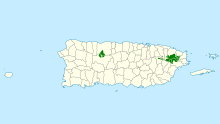
Back ببغاء بورتوريكو Arabic ببغاء بورتوريكو ARZ Пуерториканска амазона Bulgarian Amazona vittata Breton Amazona de Puerto Rico Catalan Amazona vittata CEB Amazoňan portorický Czech Amason Puerto Rico Welsh Puerto-Rico-Amazone German Puertorika amazono Esperanto
| Puerto Rican amazon | |
|---|---|

| |
| Scientific classification | |
| Domain: | Eukaryota |
| Kingdom: | Animalia |
| Phylum: | Chordata |
| Class: | Aves |
| Order: | Psittaciformes |
| Family: | Psittacidae |
| Genus: | Amazona |
| Species: | A. vittata
|
| Binomial name | |
| Amazona vittata (Boddaert, 1783)
| |
| Subspecies | |
| |

| |
The Puerto Rican amazon (Amazona vittata), also known as the Puerto Rican parrot (Spanish: cotorra puertorriqueña) or iguaca (Taíno), is the only extant parrot endemic to the archipelago of Puerto Rico, and belongs to the Neotropical genus Amazona. Measuring 28–30 cm (11.0–11.8 in), the bird is a predominantly green parrot with a red forehead and white rings around the eyes. Its closest relatives are believed to be the Cuban amazon (Amazona leucocephala) and the Hispaniolan amazon (Amazona ventralis).
The Puerto Rican amazon reaches sexual maturity at between three and four years of age. It reproduces once a year and is a cavity nester. Once the female lays eggs she will remain in the nest and continuously incubate them until hatching. The chicks are fed by both parents and will fledge 60 to 65 days after hatching. This parrot's diet is varied and consists of flowers, fruits, leaves, bark and nectar obtained from the forest canopy.
The species is the only remaining native parrot to Puerto Rico and has been listed as critically endangered by the World Conservation Union since 1994. Once widespread and abundant, the population declined drastically in the 19th and early 20th centuries with the removal of most of its native habitat; the species has completely vanished from Vieques and Mona Island. Conservation efforts commenced in 1968 to save the bird from extinction.
- ^ BirdLife International (2020). "Amazona vittata". IUCN Red List of Threatened Species. 2020: e.T22686239A179276011. doi:10.2305/IUCN.UK.2020-3.RLTS.T22686239A179276011.en. Retrieved 12 November 2021.
- ^ "Appendices | CITES". cites.org. Retrieved 14 January 2022.
